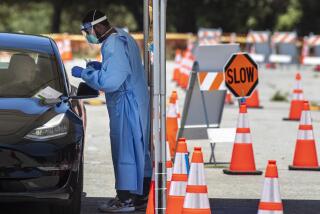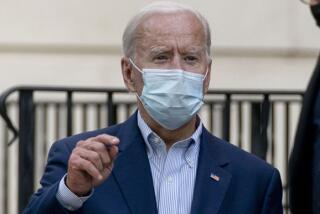Editorial: Coronavirus whack-a-mole isn’t working. It’s time for a nationwide shutdown

The U.S. marked a grim milestone Thursday when it overtook China as the nation with the most confirmed cases of COVID-19. By Friday, the caseload had grown by an additional 19,000, to more than 100,000. And those are just the cases we know about; many thousands of tests have yet to be processed and many, many sick people have been unable to get tested at all.
Scientists tracking the virus believe that the official number represents just a small fraction of all the coronavirus infections in the U.S. And indeed, as more states ramp up testing, more infections are discovered in every part of the country, not just in coastal hot spots. There are now COVID-19 cases in all 50 states.
On Thursday, President Trump sent a letter to the nation’s governors saying his coronavirus task force was developing new guidelines for social distancing strategies that would categorize counties by risk level. Apparently, the administration believes it can recommend different rules of behavior for different counties based on presumed levels of risk there.
But that won’t work. Public health officials simply don’t have the data yet to say with any authority where the virus is and where it isn’t. And with so many people still moving around the country, including New Yorkers fleeing the city for less populated places, it should come as no surprise that the infection has spread to every state in the union.
Instead, what the president ought to recommend is that all states adopt the same kind of stay-at-home restrictions — along with the closing of businesses and venues where people gather — that California, New York and other hard-hit states have. And that they do so immediately. That’s the way to get out in front of the pandemic and stop the spread decisively. China took such aggressive measures in January, and they appear to have paid off. The United States must do the same. Otherwise, the country faces the threat of more death and disease — and even longer shutdowns when they eventually come.
Trump, sadly, seems disinclined to call for this, even though most public health experts say that the data support more drastic interventions, not fewer. The president is apparently under the delusion that there’s some way to safely get America back to work in the next two weeks, despite the fact that the country still lacks the ability to monitor, test, isolate and treat infected people or to trace the disease to prevent its continued spread.
Believe us, we want to get the nation back to work just as badly as he does. The shutdowns in California and other states have already caused tremendous economic pain, and are certain to cause a good deal more in the months ahead. Last week, 3.3 million Americans filed for unemployment, not just breaking the historical record of 695,000 in a single week, but demolishing it. And that’s almost certainly an undercount, because the onslaught of calls and online applications overwhelmed state unemployment agencies.
But just because we want the nation back at work doesn’t mean it can happen just yet. The fact is that the aggressive social distancing actions came too late in California and New York, where infections and death continue to surge. That’s because the coronavirus was spreading invisibly long before the shutdown orders were made. That should serve as a lesson to every city or region that thinks a lack of reported COVID-19 cases means it is safe. The whack-a-mole approach is not effective against a virus that spreads so stealthily.
Since the president does not have the authority to issue a nationwide shutdown order (and probably wouldn’t do so if he could), the nation’s governors must step up and take measures to shut down the spread of COVID-19 themselves, and do so in a coordinated and uniform way, at least for the next few weeks and until we have much more testing data. So far, that’s not been happening. While about 23 states have made the difficult choice to order residents to stay home, others have not. Despite surging infection rates in Florida and Georgia, for example, the governors of those states have resisted calls for statewide shutdown.
We understand this is a wrenching decision for governors to make right now, especially if their states still have a relatively low number of COVID-19 cases. It means further imperiling the fortunes of their residents as part of a fight against an outbreak that they’re not yet seeing at any significant scale.
But public health experts overwhelmingly agree that it’s the only effective way forward. If we do this now while undertaking aggressive and strategic testing and surveillance, we can get ahead of the pandemic and, hopefully soon, get safely back to work.
More to Read
A cure for the common opinion
Get thought-provoking perspectives with our weekly newsletter.
You may occasionally receive promotional content from the Los Angeles Times.










